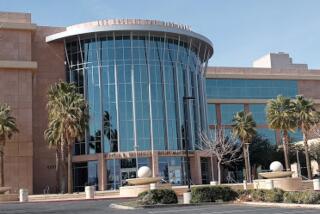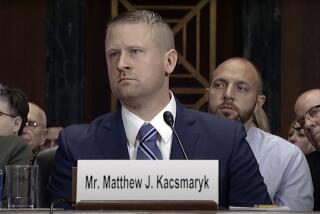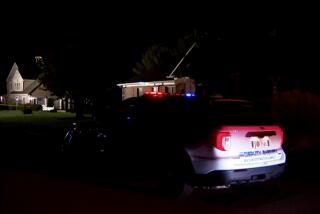Had to Restrain Judge, Police Say
Superior Court Judge Robert Bradley had to be physically restrained to keep him from leaving the Santa Paula police station last Saturday, when the veteran jurist was arrested on suspicion of drunk driving for the second time in a month, authorities confirmed Friday.
Also, at roadside early in last weekend’s arrest, Bradley asked officers: “Do you know who I am, do you know who I am?’ ” Santa Paula Police Chief Walt Adair said.
“The sergeant replied, ‘Yes sir, I do.’ And the process went on.”
Despite these two incidents, Adair said the judge was generally cooperative and deeply embarrassed as he left the station about three hours after his 8:45 p.m. arrest.
“He did try to leave during fingerprinting,” Adair confirmed. “He said he was going to walk out, and the sergeant did physically restrain him. He grabbed the judge by the sweater, put him in a wristlock, a pressure hold, and walked him back into the jail.”
But the incident lasted only a few seconds, and Bradley had walked only a few feet when apprehended, Adair said.
“I wouldn’t say he was abusive,” the chief said. “The judge was intoxicated and everybody knew that. So he was being treated as a person who had been drinking, and you would expect a person who had been drinking to say things that are irrational and don’t make sense.”
Adair said the booking incident did not rise to the level where the judge should be charged with any additional crime: “It wasn’t out of character for someone who’d been drinking. Any time you’re dealing with someone who’s been drinking, his behavior floats back and forth.”
Bradley, 56, who returned to work Monday after a month in an alcohol rehabilitation center and who announced his candidacy for reelection Thursday, has declined comment. His attorney, George Eskin, said he is in no position to doubt police accounts.
“I’m not questioning what police officers have told you, or what statements they attribute to Judge Bradley in his state of intoxication,” Eskin said.
Meanwhile, the director of the state Commission on Judicial Performance, confirmed Friday that her agency is investigating Bradley because of the drunk driving arrests.
“The commencement of the commission’s investigation is not a determination of judicial misconduct,” said a release from director Victoria B. Henley’s office. “This explanatory statement is issued . . . in light of the public interest expressed in this matter.”
Eskin said he assumed the investigation was ongoing since Bradley notified the commission of his arrests by letter shortly after they occurred Dec. 6 and Jan. 3.
In an interview Friday morning, Adair also said that Bradley apparently had a minor accident before his arrest that led to a flat tire, a broken headlight and scraped paint on the vehicle’s right front fender.
“It appeared that he had hit something,” Adair said. “Probably a curb or a highway marker.”
No damage to any other car or stationary object was found at or near the scene, the chief said. Nor have there been reports of a hit-and-run accident near that time, officers have said.
Bradley was arrested after a Santa Paula officer saw him trying to fix a flat in a traffic lane of Peck Road near the Santa Paula Freeway, and followed the judge’s Toyota Camry to a nearby gas station to help him change the tire.
Bradley acted as if he was under the influence of alcohol and was taken into custody, authorities said.
*
Police Cmdr. Robert Gonzales said Friday that he spoke to Bradley within a few minutes of the arrest, and the judge was slurring his words and having problems balancing.
Gonzales also said that Bradley’s conduct was good overall--that he was “a gentleman” when talking with Gonzales, whom he had known for many years professionally.
But Gonzales said he was called to help in the fingerprinting incident where Sgt. Michael Saviers restrained the judge shortly after the arrest.
“The judge said, ‘I don’t want any of this. I’m outta here, I’m leaving.’ And the officer called for help,” Gonzales said.
“When I got there they were just standing there looking at each other,” Gonzales said. And I told the judge, ‘We’re going to finish this. It’s not a good position for you to be in or us to be in. But in this case, Bob, you’re not a judge, you’re like any other citizen, and you’ll be treated like such. So let’s finish this, and the sooner the better.’ ”
Bradley declined to submit to an alcohol breath test and was taken to a local hospital for a blood-alcohol test, Gonzales said. The results are not due back for another week. But after Bradley’s first arrest Dec. 6 in Ojai, a breath test showed his blood-alcohol level was 0.21--more than double the legal limit of 0.08.
Crime reports on both cases have been forwarded to the attorney general’s office for prosecution. Eskin said he expects misdemeanor charges to be filed soon, and believes Bradley will plead guilty.
But Bradley, a judge since 1983, will stay in office even if he is convicted of misdemeanor driving under the influence of alcohol, as allowed by state law, Eskin said.
Whether Bradley survives the June 2 election is another matter.
*
The judge has said through Eskin that he will file to run for his third six-year term by the Feb. 4 deadline.
But Deputy Public Defender Gary Windom, who tries high-profile cases, said this week that he may run against Bradley because allowing him to remain on the bench fosters distrust of the courts.
The judge must also weather the judicial commission inquiry announced Friday.
Commission director Henley said Bradley could be cleared of wrongdoing or face a range of penalties--a simple warning, public or private admonishment, censure for unprofessional conduct or removal from office.
The state Constitution sets out the penalties for judges beyond the 30-day minimum jail sentence, fine and driver’s license suspension that usually accompany a second drunk-driving conviction.
The judicial commission can suspend a judge for official misconduct or disability even before the jurist’s case is heard if it determines that “continued service of the judge is causing immediate, irreparable and continuing public harm,” the Constitution says.
After that, the commission may “remove a judge for conduct that constitutes . . . habitual intemperance in the use of intoxicants or drugs.”
The Constitution also requires removal if a judge is convicted of a felony or offenses of moral turpitude, Henley said.
But DUIs do not usually involve moral turpitude that would spark removal, she said.
Nor would Bradley’s alleged drunk driving qualify him for felony prosecution unless convicted of the charge four times, lawyers have said.
More to Read
Sign up for Essential California
The most important California stories and recommendations in your inbox every morning.
You may occasionally receive promotional content from the Los Angeles Times.










